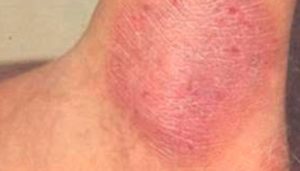What are the causes of neurodermatitis and what are the symptoms? How can this disease be detected? This article shows how.
Block rate>Neurodermatitis is a skin condition that starts with an itchy skin spot. Scratching makes it it itchier. This itching cycle causes the affected skin to become thick and leathery. You may develop several itching spots, typically on the neck, wrist, forearm, thigh or ankle.
neurodermatitis – also known as lichen simplex chronicus – is not life-threatening or contagious. But the itching can be so severe or recurrent that it disrupts your sleep, sexual function and quality of life.
Breaking through the itching and scratching cycle of neurodermatitis is a challenge. The success of treatment depends on resistance to the urge to rub or scratch the affected areas. OTC and prescription creams can alleviate itching. They must also identify and eliminate factors that can aggravate the problem.
Symptoms of neurodermatitis
Signs and symptoms of neurodermatitis include:
- an itchy skin patch or patch
- Leathery or flaky texture at the affected areas
- a raised, rough spot or stain that is red or darker than the rest of your skin
These are areas that can be reached for scratching – head, neck, wrist, forearm, ankles, vulva, scrotum or anus. The itching, which can be intense, can come and go or be continuous. They can scratch out of habit and in their sleep.
Check with your doctor if:
- You catch yourself repeatedly scratching the same spot of skin.
- Itching prevents you from sleeping or concentrating on your everyday life.
- Your skin becomes painful or looks infected.
Causes of neurodermatitis
Causes
The cause of neurodermatitis has still not been researched by scientists to this day. Atopy plays the music. D.h. it has inherited skin and mucous membrane hypersensitivity with the presence of atopic eczema, sensitive rhinitis and susceptible Asthma. In addition to atopic diagnosis, some foods and other environmental factors (e.g. trigger factors) have a positive effect. The exact cause of neurodermatitis is not known. Sometimes neurodermatitis starts with something that simply rubs or irritates the skin, such as tight clothing or an insect bite.
If you rub or scratch the spot, it itches even more. The more you scratch, the more it it itches.
In some cases, neurodermatitis is associated with other skin diseases – such as dry skin, eczema or psoriasis. Stress and anxiety can also cause itching.
Risk factors for neurodermatitis
Certain factors may affect your risk of neurodermatitis, including:
- your gender and age. Women develop neurodermatitis more frequently than men. The disease most frequently occurs between the ages of 30 and 50.
- Other skin diseases. People with a personal or family history of dermatitis, eczema, psoriasis or similar skin diseases tend to develop neurodermatitis.
- anxiety disorders. Fear and stress can cause the itching associated with neurodermatitis.

Prevalence of neurodermatitis
Severity
The peculiarity of neurodermatitis is extremely dependent on the age of the patient. It depends on age and therefore varies from one part of the body to the next. Symptomatic of the disease is the powerful itching and brittle skin and hair. Although there may be an individual skin rash without pruritus. In babies, the disease is visible on the cheeks and around the head. Gradually, the whole face, trunk and extensor side of all or individual limbs are affected. First of all, redness with blisters and papules appears. In childhood and adolescence, the two elbows, the backs of the feet, the wrists, the inside of the knees and the neck are affected by the disease. The affected skin areas show a reddish coloration with papules. In adulthood, the joint bends, the backs of the hands and feet, the face, trunk and neck are predominantly affected by the disease.
More specifics of the disease
Further characteristics of the disease are the lack of frontal eyebrows, lower lid wrinkles on both sides, cracks in the corner of the mouth, dried lips, earlobe ridges, cracks in the skin, reduced size of the hydrose, dried out dandruff as well as in the face and on the limbs of the arms. In a few cases, eye changes occur. It has been proven that wet and/or damaged skin rashes are often “afflicted” by infectious agents. This causes ulcerating stinking skin inflammations or a blister rash. Both symptoms are associated with fever. The disease only worsens constantly due to psychological stress, such as the weather, various detergents, different clothing materials, some foods. A palpable recovery usually occurs during climate change.
The disease improves with age
Neurodermatitis is a persistent or recurrent skin inflammation with severe attacks, which is associated with pruritus, reddish coloration, wetness, scaling and crust formation. The disease is an atopic disease and currently affects more than 3.8 million people. The therapy of the disease requires an individually adapted concept. A complete cure is unthinkable. There is always an alleviation of eczema and itching. Regular skin care with oily ointments is recommended as a basic therapy.




